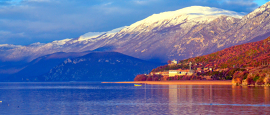Getting around Albania
Travelling by car is one of the most practical ways to explore Albania, offering flexibility and access to remote areas. The country has an expanding road network, with major highways connecting key cities such as Tirana, Durrës, Shkodër, Vlorë, and Sarandë. In recent years, Albania has made significant improvements to its infrastructure, with new highways and bypasses reducing travel times on key routes.
Fuel stations are common along major routes, and petrol prices are in line with European averages. Road signs are mostly in both Albanian and English. However, beware that GPS navigation can be unreliable in remote areas.
Highways and main roads are generally in good condition, but secondary and rural roads may be narrow, winding, and occasionally potholed. Mountainous regions, such as those leading to Theth or Valbona, require extra caution, as some routes are unpaved or challenging for standard vehicles, especially in bad weather. Driving habits in Albania can be unpredictable, with occasional aggressive overtaking and limited adherence to traffic rules.
Car hire is widely available. Many rental agencies require drivers to be at least 21 years old.
Officially licensed taxis in Albania are mandated to use meters and display their rates prominently. These vehicles are typically identifiable by yellow license plates and company logos. However, the prevalence of meter usage can vary. In Tirana, for instance, many taxis operate with meters, but sometimes drivers may propose fixed fares, especially for specific routes or during peak hours.
Ride-hailing services like Bolt, Speed Taxi and UPs Taxi operate in Tirana and offer more predictable pricing.
Intercity buses and coaches are a popular and affordable way to travel in Albania, with numerous private operators offering regular services between key destinations such as Tirana, Durrës, Shkodër, Vlorë, Sarandë, and Gjirokastër.
Larger cities have designated bus terminals, but schedules can be informal, with buses often departing only when full rather than at fixed times. Despite this, services between major destinations run frequently throughout the day. Tickets are usually purchased on board, and comfort levels can vary depending on the vehicle.
Furgons, smaller minivans, provide a faster yet slightly less regulated alternative. These often stop along the route to pick up or drop off passengers, making them a convenient but less predictable option for getting around.
Speed limits are generally set at 40 km/h (25 mph) in urban areas, 80–90 km/h (50–56 mph) on rural roads, and 110 km/h (68 mph) on motorways. Seatbelt is mandatory for all occupants in the vehicle. The legal blood alcohol limit is notably stringent, set at 0.01%, effectively meaning that any alcohol consumption could result in exceeding the permissible level. Using a mobile phone while driving is prohibited unless a hands-free system is employed.
Call the insurance company or the Automobile Association of Albania (+355 69 607 0888).
Foreign drivers should have a valid passport, driving licence, an International Driving Permit (if the licence is in a non-Latin script or as required by the car rental company), vehicle registration documents, and proof of insurance.
In cities across Albania, buses and minibuses (furgons) are widely available and provide a straightforward means of getting around. However, they often operate without fixed schedules and can become crowded during peak hours, so some flexibility is advised.
Taxis are commonly used in Tirana, Durrës, Vlorë, Shkodër, and Sarandë. While most taxis are metered, some drivers may propose fixed fares, so it's wise to confirm pricing before starting your journey. Ride-hailing apps are also available in Tirana, offering more predictable and convenient options.
Walking is an excellent way to explore central Tirana, with major attractions like Skanderbeg Square and the trendy Blloku neighbourhood located within easy walking distance. For a more active option, cycling is growing in popularity, supported by improving bike rental services and an expanding network of dedicated cycling paths.
Do you have any Feedback about this page?
© 2025 Columbus Travel Media Ltd. All rights reserved. No part of this site may be reproduced without our written permission, click here for information on Columbus Content Solutions.




 You know where
You know where